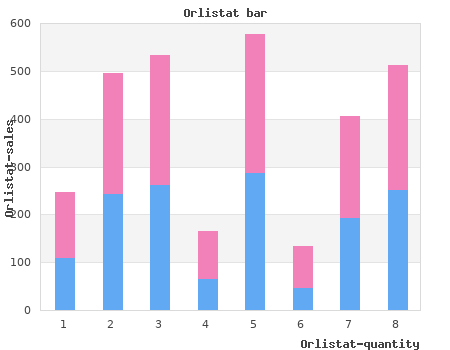2017, Sweet Briar College, Folleck's review: "Orlistat 120 mg, 60 mg. Discount Orlistat OTC.".
This is important because intellectual contributions are far more valuable to the advancement of papers than comments on grammar and organisation orlistat 120mg. When papers are badly constructed and poorly written orlistat 60 mg low cost, reviewers tend to concentrate on trying to fix the immediate problems of presentation rather than thinking about the content and the big picture. This, in turn, prompts an endlessly frustrating review-edit-amend roundabout without any major focus on content. Naturally, it is better if a paper stays on a sensible and planned track from day one rather than being continually pushed and pulled into everyone’s different ideas of what shape it should take. Constructing a paper with well- articulated aims from square one tends to focus on content and to ensure that major structural changes are not requested at the end, just when you thought you were finished. If you can achieve this, the whole review process is shorter and more purposeful, and everyone enjoys the rewards of seeing the paper progress quickly towards a publishable document. By asking for peer review, you are in effect asking colleagues to assist you with the scholarship of your work. You should never pass a draft out for review before it is truly ready, that is before it has reached the highest standard to which you can take it. The thoughtlessness of repeatedly handing out ill-prepared documents tends to wear reviewers down. To receive the most valuable feedback, drafts must be at the highest standard that you can possibly achieve before you ask your colleagues for comment. This will ensure that everyone spends their time efficiently because the number of drafts is minimised and the quality of the feedback is maximised. By incorporating each reviewer’s improvements before you pass the document on again, the next reviewer receives the most advanced version of your work and coauthors do not have to duplicate each other’s work. Some groups of coauthors find it is very productive to hold miniwriters’ groups and brainstorm some ideas together rather than reviewing in isolation. It is important to find a reviewing process that is both efficient and suits the work practices of your authorship team. As well as taking the coauthors’ and reviewers’ comments on board, you need to continually work on each paragraph so that the topic sentence is accurate and correct, the grammar is flawless, and the sentences have a minimum number of words and flow together nicely.

Psychosocial Influences on the Experience and Expression of Pain During Childhood McGrath (1994) described a model depicting psychosocial factors that af- fect a child’s pain perception cheap 120 mg orlistat with amex. The model includes consideration of cogni- tive purchase orlistat 120mg without a prescription, behavioral/social, and emotional factors. Individual child characteris- tics, including age, are thought to be related to each of these factors, which in turn can influence children’s pain experiences (McGrath, 1994). Cognitive factors include children’s understanding of the cause of their pain, expectations regarding continuing pain and treatment efficacy, the rel- evance or meaning of the pain, and coping strategies (McGrath, 1994). Con- siderable research has examined children’s concepts of general illness from a developmental perspective (Bibace & Walsh, 1980; Burbach & Peter- son, 1986), with most data suggesting that children’s concepts of illness evolve in a systematic, age-related sequence, consistent with Piagetian the- ory of cognitive development. Far less research has examined the develop- mental course of children’s specific understanding of pain. Harbeck and Pe- terson (1992) found, among a sample of children and youth aged 3 to 23 years, that older children and youth had more complex and precise under- standings of pain than younger children. For example, children in the preoperational stage of development were unlikely to be able to offer an ex- planation for the value of pain, whereas children in the formal operations stage were able to acknowledge that pain often carries a preventative or di- agnostic value (Harbeck & Peterson, 1992). Ability to understand the cause and value of pain is likely related to pain perception, although no research has explored the links between children’s understanding of pain and subse- quent pain responses. Research has also confirmed the presence of age- related differences in children’s predictions of pain intensity, with younger children making less accurate predictions than older children (von Baeyer, Carlson, & Webb, 1997). Children’s coping strategies for dealing with pain are an area that has re- ceived considerable research attention (Bennett-Branson & Craig, 1993; Reid, Gilbert, & McGrath, 1998). Reid and colleagues (1998) detailed the devel- opment of a measure of pain coping in children that assessed coping in three broad areas: approach (e. Use of this measure among a sample of children aged 8 to 18 years revealed that adolescents (13–18 years) reported higher levels of emotion-focused avoidance than children aged 8 to 12 years (Reid et al. The authors attributed this finding to increased frequency of pain among adolescents for which they may experience difficulties managing and consequently re- sort to more emotion-focused avoidant approaches. Other research has examined children’s coping with postoperative pain (Bennett-Branson & Craig, 1993).

For some postgraduate degrees cheap 60mg orlistat otc, there is no scope for modification and resubmission order 120mg orlistat with visa, so that your thesis has to be “perfect” the first time around. The marking system can be quite complex before the exam process is finalised. To avoid disappointment or unexpected delays, it is a good idea to ask your supervisor to explain the system that is used at your institution. Acknowledgements All referenced quotes have been produced with permission. Suffocation, shaking or sudden infant death: can we tell the difference? Similar, the same or just not different: a guide for deciding whether treatments are clinically equivalent. Effectiveness of home based support for older people: systematic review and meta-analysis. Mimi Zeiger1 The objectives of this chapter are to understand how to: • begin each paragraph with a purpose • understand the basic format of sentences • achieve clarity, brevity, and precision in your writing • create an easily readable paper • avoid common problems in sentence construction The style in which you write and present your paper is of fundamental importance for achieving brevity and clarity. To convey messages effectively in written form, it is essential to have organisation both between and within your paragraphs. Further resources on how to write clearly and effectively and educational material additional to the information presented in the following chapters can be found on the web (www1–5). Australian Government Publishing Service2 Plain English is “the art of using language that the intended audience can understand and act upon from a single reading” (www3). This concept has been widely adopted by many 188 Writing style government and legal organisations, and, in some countries, new laws must now be drafted in plain English. The Plain English Campaign that began in 1979 has promoted the use of crystal clear language and campaigned against jargon, gobbledygook, and other confusing language. The campaign also recognises that appearance matters and that the design, typeface, and layout of a paper can be as important as the language for conveying meaning. The campaign website provides free guides to plain English, details of training courses and a range of example material including a collection of gobbledygook entitled “Utter drivel”. In the following sections, we outline our own tips and examples of how to write in plain English.




